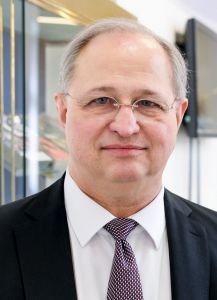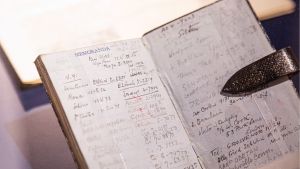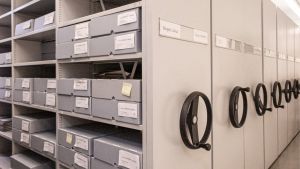Austrian musicologist Gerold W. Gruber is the founder and head of the mdw’s exil.arte Centre. exil.arte functions as a point of contact and interface for research on as well as the reception, preservation, and presentation of works by Austrian composers, musicians, and music researchers who were deemed “degenerate” by the Third Reich.
The exil.arte Centre has been part of the mdw since 2016—and it has already compiled an extensive archive that includes music composed in exile, material that it makes accessible not only to scholars and artists but also to music-lovers via exhibitions, concerts, workshops, seminars, publications, courses, etc. As part of the Long Night of Research on 8 May 2020, interested visitors will learn what happens when a Nachlass—which, in this case, means a music-related estate or legacy—is acquired by the Centre. And in the following interview, Gerold Gruber gives us a brief initial look into the Centre’s work.
Since when has exil.arte existed, and what exactly does it do?

Gerold Gruber (GG): exil.arte was first founded as an association in 2006 in order to put music whose creators were forced to flee, proscribed, or murdered back onto our concert and opera stages. To this end, we began organising concerts that included this music at places like the Jewish Museum Vienna, Haus der Musik, and other venues in Austria and abroad—and the reactions were so positive that we managed to put on over 100 concerts as well as produce several CDs during our first ten years of existence.
How does one get such an idea?
GG: As a Schönberg researcher, it was natural for me to also study Schönberg’s circle—and I soon realised how that circle produced a large reservoir of interesting music that had yet to be played or researched. So I viewed it as both a challenge and an obligation to recover such music from the past.
How do you go about acquiring a Nachlass?
GG: Austria has the privilege of being able to run dozens of Cultural Forums worldwide, and their employees have gathered a great deal of knowledge about the exiled individuals in their respective countries. This information is now benefitting us. We’re constantly receiving information about individuals, children, and grandchildren who are interested in having their respective ancestors’ life’s work properly cared for and also published.
What was the first Nachlass you received?
GG: As a music researcher, I’ve always had a special thing for Nachlässe. Ever since my student days, I’ve been a frequent guest both at the Austrian National Library’s Department of Music and at the Vienna City Library, and I’ve been fascinated by the aura that surrounds their originals—no matter whether they’re by Schubert, Beethoven, Mahler, or Berg. But the first Nachlass that I was able to bring to Vienna was actually a Vorlass [a donation of one’s estate while still alive]—namely that of Walter Arlen, who’s currently 99 and lives in Los Angeles. So in Arlen’s case, I also had my first opportunity to confront myself both with autograph manuscripts and with the one individual who could give me first-hand information on them—which was quite an extraordinary experience!
How does one get into contact with the owners of Nachlässe, and what procedure does that entail?
GG: As soon as we’ve located that person or entity whom we call the “legal successor”, and if they’re willing to give us musical materials as well as documents, photos, costumes, and other such things, we of course have to examine and clarify the associated legal issues—especially in terms of ownership and exploitation rights. We offer legal successors a choice between giving us their materials as donations or as loans. And we always keep in mind that we’re aiming not just to examine and hold the materials, but also to make them accessible to the public.

What happens to a Nachlass when it arrives at the exil.arte Centre?
GG: First, our archivist compiles an initial inventory as soon as it reaches us so that we have an overview of what it contains right from the beginning. The second step is to create a catalogue of the individual works that it includes. And once that’s done, it’s placed in storage at our archive—in stable conditions of 20° C and 50% humidity.
What legacy were you most delighted to receive?
GG: Most legacies take an average of between one and two years to reach us at the Centre. In the case of Hans Gál’s Nachlass, I spent a full ten years conferring with his daughter Eva about possibly moving it to Vienna. She and I have since become friends, and I was especially delighted at how she more or less “waited” for the Centre to be opened in 2016 before ultimately presenting us with her father’s Nachlass.

What’s special about the exil.arte Centre compared with other such institutions?
GG: We’re an active centre rather than just an archive. This entails that while we by no means scoff at archival work, we do also pay a great deal of attention to making the materials accessible to the public once more in the form of exhibitions, concerts, publications, and the like.

